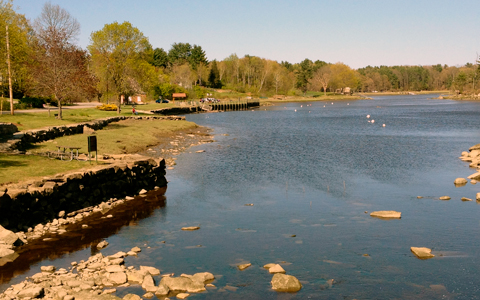
The grant funding process is highly competitive, with numerous state agencies and municipalities facing similar challenges while vying for the same funding sources. The American Rescue Plan Act of 2021 (ARPA), Infrastructure Investment and Jobs Act (IIJA), and the Inflation Reduction Act (IRA) have opened the doors to future investments for our communities and they now need to determine the highest and best use of the funds to invest in projects that will have a meaningful impact.
Two towns in New Hampshire, Durham and Exeter, needed assistance with preparing grant applications to enhance flood resilience and address aging dam infrastructure needs. Based on experience, the communities turned to VHB to help craft the grant applications, secure funding, and to better position their projects for success.
Town of Durham, NH
Four separate grants were secured through the New Hampshire Department of Environmental Services (NHDES), National Oceanic and Atmospheric Administration (NOAA), and the National Fish and Wildlife Foundation (NFWF). These grants, exceeding $4 million, are being used for the restoration of the Oyster River through the removal of the Mill Pond Dam. The dam, also known as the Oyster River Dam, is located at the head of tide where the Oyster River flows through the Town of Durham and changes from freshwater to saltwater. The Oyster River is a major tributary of the Great Bay, one of the largest, most ecologically significant estuaries on the east coast, with an area of approximately 6,000 acres.
Constructed in 1913, the 140-foot-long concrete structure consists of a spillway, a set of gated outlets at the right abutment, and a fish ladder at the left abutment. The dam’s impoundment of the Oyster River is approximately 20 acres, including the 9.5-acre Mill Pond. Owing to structural deficiencies and its inability to safely pass a 50-year storm event, the dam does not meet current NHDES safety standards. Mill Pond’s declining water quality poses another ongoing concern.
After evaluating alternatives in a 2020 feasibility study, and years of discussion, the Town eventually voted to remove the Mill Pond Dam as the most cost-effective, constructable, and sustainable solution for addressing the dam’s safety issues, as well as Oyster River’s environmental concerns.
The project’s four-part plan includes the removal of the existing dam structure, abutment preservation, channel shaping, and upstream channel restoration. The main dam spillway and the adjacent fish ladder will be entirely removed, but portions of the abutments and perhaps a section of the spillway may be left in place to help mitigate historic impacts. The channel will be reshaped to provide fish passage under low flow conditions. The active restoration of the Oyster River channel will also involve the removal of sediment deposited in the center of the Mill Pond impoundment, which will minimize potential sediment impacts downstream, as well as improve the stability and ecological integrity of the upstream area following dam removal. The project will stabilize the river and include a plan to control the spread of invasive plants. Additionally, because the grant applications were so successful, the Town has been able to expand the scope to further improve fish habitat in the watershed. A “fish ladder” or nature like bypass channel will be installed at the next dam upstream―the “Oyster Reservoir Dam”―which is about 1.8 river miles upstream from the Mill Pond Dam, which will further improve fish habitat in the watershed.
Project goals include reducing Durham’s vulnerability to flood risk, improving water quality by restoring a natural flow regime, and reestablishing a healthy ecosystem for the Oyster River’s anadromous fish populations. The project will also enhance Durham’s resilience in the face of projected sea level rise. The construction phase of the project is expected to begin in summer 2024, with removal of the dam and restoration of the river expected to be completed by year’s end. Installation of the fishway at the Oyster Reservoir Dam is expected to occur in 2025.
“With the increasing impacts of climate change, selective dam removal is one of the most effective tools we have to improve resiliency in our communities,” said Peter Walker, VHB Principal, Environmental Planning. “There’s significant planning that goes into dam removal that can often take years; however, the environmental benefits are worth it.”
Town of Exeter, NH
VHB helped secure three grants through the NHDES for two dams in Exeter. Both the Exeter Reservoir Dam and the Pickpocket Dam are high hazard dams whose spillways do not pass the required discharge capacity. In 2016, VHB performed an updated hydrologic and hydraulic analyses for both dams, which showed that failure during a 100-year storm event would be likely to overtop critical roadways, making them impassable. Additionally, flood heights were predicted to reach greater than one foot above the first-floor elevation of residential structures downstream of the dam, which could result in loss of human life. Dam failure of the Exeter Reservoir Dam would also impact the surface water treatment plant, which provides a large portion of Exeter’s potable water (more than 4,500 customers). Ultimately, the study showed that the hazard class of the both dams was High Hazard, and that the spillway capacities were significantly under the discharge requirements.
For the Exeter Reservoir Dam, VHB helped the Town secure a NHDES High Hazard Dam Rehabilitation Grant, funded through ARPA, to perform a feasibility study to evaluate options to bring the dam into compliance, as well as make it eligible for future grants. The grant also facilitates updates to the Emergency Action Plan and Operation, Maintenance and Response Form, which have not been updated since 2006.
VHB also helped secure two grants through the NHDES for the Town to complete a feasibility study to evaluate modification or removal of the Pickpocket Dam. One grant was secured through the NH Coastal Program in part funded by NOAA’s Office for Coastal Management and the second through the NHDES Clean Water State Revolving Fund (CWSRF) with ARPA funding. The sediment analysis and climate change evaluation components of this project are key elements to advancing the feasibility study, which will assist the Town in determining how best to bring the dam into compliance or removal. The feasibility study also includes the evaluation of hydraulic and environmental components, with the goal of increasing safety and resiliency, and improving aquatic and bordering riparian habitat along the Exeter River. In October, the Board of Selectmen, and the River Advisory Committee, both unanimously voted to move forward with dam removal. The grants obtained, as well as preliminary results from the feasibility study, spurred the early decision and subsequent application for a third grant application (recently submitted), funded by NOAA and entitled “Restoring Fish Passage through Barrier Removal Grants Under the BIL and IRA”.
“Dams are used extensively across the country for a variety of purposes and, while well-designed and properly managed dams can provide benefits, they can also drastically alter a natural river and impact fish populations,” said Jacob San Antonio, VHB Chief Engineer, Water Resources. “The Town of Exeter now has the opportunity to further restore the Exeter River’s health and reconnect and restore more than 14 river miles to a free-flowing condition.”
How VHB Can Help
VHB has a strong understanding of the federal grant processes related to funding the planning, design, construction, and operations of infrastructure. We’ve worked with clients to prepare applications and secure competitive grants that have translated into substantial benefits for communities. VHB is here to help you understand and navigate potential funding opportunities for your next project. For example, the U.S. Fish and Wildlife Service recently announced the availability of $36 million in funding through their National Fish Passage Program, providing a new opportunity for communities and organizations interested in improving stream habitat. Letters of Interest are due November 17, 2023.
To learn more, connect with Pete or Jake, and visit our navigating the grant funding process page.


